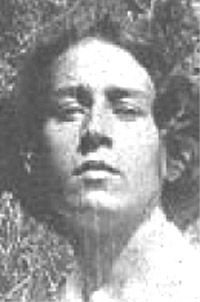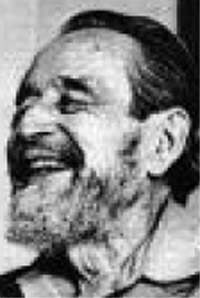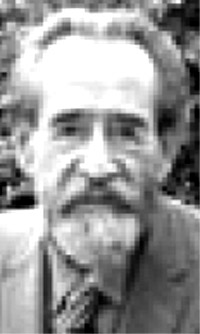Dane Rudhyar
Michael D. Robbins © 2003Astro-Rayological
Interpretation & Charts
Quotes
Biography
Images and Physiognomic Interpretation
Dane Rudhyar
Author, Astrologer, Composer, Artist, Modern Renaissance Man
(1895-1985?) March 23, 1895, Paris, France, 00:42 AM,. (Source: from his wife, L. Rael, taken from a given time of “midnight to 1:00 AM”, and used by Dane Rudhyar, himself.) Died, September 13, 1985, San Francisco, CA

(Ascendant, Sagittarius; MC, Libra; Sun and Venus in Aries; Moon in Aquarius; Mercury and NN in Pisces; Mars, Pluto and Uranus all conjunct in Gemini, with Mars/Neptune conjunct the seventh house cusp, and Jupiter also in Gemini; Saturn and Uranus in Scorpio)
Dane Rudhyar was a pioneer (Sun in Aries) in the field of transpersonal astrology, also known as “Humanistic Astrology”. He was deeply interested in the psycho-spiritual meaning of astrology (evidence of his second ray soul and his Rising Sign, Sagittarius), focussing far less upon the event level of astrology — though he was surely capable of doing so (offering significant rectifications of the charts of many important individuals, including the chart of Alice A. Bailey his close friend and, presumably, ashramic brother). His search was for the archetypal patterns (second ray and Sagittarius) which caused and gave significance to outward manifestations.
Rudhyar wrote voluminously (expansive Jupiter, exoteric ruler of his Sagittarian Ascendant in verbal, thought-filled Gemini) on astrology and related psycho-spiritual fields. Mars, exoteric ruler of his Aries Sun, conjunct both Pluto and Neptune in Gemini, promotes intensity and depth in the expression of thought. A high note of idealism sounds through his writing as a result of this Mar/Neptune conjunction—both planets of the sixth ray. Additionally, the Sun is found in the third house of mind, and also the house of the writer and thinker. Further, the North Node (indicating a focus to be applied) is also placed there.
His was a mind of unusual subtlety, sensitivity and depth (Mercury, the esoteric ruler of the Sun sign—valid in the chart of initiates—in Pisces, exoterically disposited by Neptune, and exoterically by Pluto, both conjunct in Gemini). His depth of psychological insight is indicated by the planet of transformation, Uranus, and the planet of realistic assessment, Saturn, both in Scorpio.
It is interesting to note the position of Chiron on the MC, conjunct the Earth (heliocentrically considered). Chiron, at its higher level of expression, is a second ray planet, a healing, guiding planet—and indeed Rudhyar was the wise guide (Chiron) to more than a generation of progressive, spiritually-inclined astrologers and spiritual seekers. Chiron, the “Quest Guide” (though placed, for Rudhyar in Libra) is naturally associated with Sagittarius, his Ascendant, and thus the indicator of soul-direction in this particular incarnation. The Earth is the esoteric ruler of Sagittarius, and is conjuncted to Chiron, indicating a practical dharma for Rudhyar as one who indicates the Path, and the wise (Sagittarius) and balanced (Libra) manner of treading it.
“Sagittarius, which is governed esoterically by Mother Earth, produces those conditions whereby the Path itself achieves glorification.”(EA 130)
Dane Rudhyar had great versatility—as a thinker, artist, philosopher, poet, metaphysician, astrologer and composer. He was a modern Renaissance man. This universality is reinforced by his four Gemini planets, with Jupiter among them trine his eclectic Aquarian Moon. More deeply, it indicates the inclusiveness of his second ray soul. He was a good friend of Alice A. Bailey (who considered him a brother in the second ray Ashram). They held each other in the highest respect. Dane Rudhyar(according to the Tibetan in unpublished writings — a “world disciple”) was one of the few people (not a member of the Tibetan’s Groups of Nine) to receive the installments of the book on Esoteric Astrology which A.A.B. and the Tibetan were in process of writing. In Rudhyar’s classic Astrology of Personality, there are a number of tabulations taken directly from the Tibetan’s books—notably A Treatise on Cosmic Fire and Esoteric Astrology.
While there can be no certainty in such matters, a reasonable ray chart for Dane Rudhyar might be conceived as follows: III 2 4-367.
His great fundamental intelligence suggests a monad upon the third ray (as is the case with at least seventy five percent of disciples in the world today, having come from the “Moon-chain”:)—a third ray which, interestingly, would find expression through the ‘Earth Point’ (considered as the Monadic Point) in third ray Libra. That his soul is focussed upon the second ray—wise and full of loving-understanding seems clear. Second ray Jupiter in second ray Gemini would be the planet and sign through which this second ray could most powerfully express, aided by intelligent, intuitive Mercury in second ray Pisces (a most intuitive placement). An artistic, expressive, versatile fourth ray personality is likely—expressing, of course, through the entire chart, but finding special points of expression through the circulatory fourth ray Aquarian Moon (the sign of which it is the hierarchical ruler) and fourth ray Mercury in intuitive, synthesizing Pisces.
His mind is hypothesized to be conditioned by the third ray of “Creative Intelligence”. Its great powers of abstraction and synthesis and its fluidity seems to suggest the third ray—reflective of a hypothesized third ray monad. (The mind, archetypally reflects the monad, just as the astral nature reflects the soul and the physical nature, the personality as a whole). As for the idealism or devotion of the sixth ray, this is much supported by the Mars/Neptune conjunction, both of them important sixth ray planets. This two/six line expressed very much through his Gemini planets, and thus through his writing. His physical appearance suggests a seventh ray body.
Because Dane Rudhyar is, presumably, linked to the second ray Ashram, and was, in fact, quite closely connected with the Tibetan Teacher, and because he was a psychologist of such depth, his rays may shine through more clearly than is the case with many well-known persons. He would be an excellent subject of study (as is Roberto Assagioli) for those interested in understanding the way of the modern, second ray disciple-initiate in the modern world.
Dane Rudhyar, like Alice Bailey, was a “world disciple”. The profundity of his thought and his commitment to the reformulation of the astrology (and especially the ‘philosophy of astrology’) indicates that he was certainly involved with the expression of the Divine Plan, the requirement for those who have passed through the second portal. The mere fact that the Tibetan considered him a “world disciple” would be an indication that he had passed the third portal or was on the verge of doing so. Of such intimate matters we cannot be the judge, nor should we be. We can only recognize that if the “Revelation of Unity” is the task of the third degree initiate, Rudhyar was (at least in terms of his thought) seemed to fulfill the requirement.
He was not necessarily an easy author to understand and assimilate (perhaps the result of a profound third ray). His writing was abstract (Mercury in Pisces trine generalizing Jupiter) but also clear (Mercury trine Saturn). He was celebrated by thousands of astrologers and spiritual seekers who understood perhaps very little of the real depth and subtlety of his thought.
Once when the author [Robbins] was a young man, he attended a national astrological convention in Houston, Texas and had the good fortune to speak with Marcia Moore (an excellent astrologer who was closely associated as a young woman with Alice Bailey and even moreso with the groups which carried on after her passing). The author, being relatively new to esoteric astrology, was in search of a “real esoteric astrologer”. He put the question to Marcia Moore: “Who do you know that is a real esoteric astrologer”? The answer came back without hesitation: “Why Dane Rudhyar. He is the most esoteric astrologer I know”. The author now appreciates the truth of her statement.
In his first great astrology book, The Astrology of Personality, (dedicated to Alice A Bailey) Rudhyar referred openly to the esoteric astrology of the Tibetan, Whose astrological instructions he was receiving at the time. Later he discontinued reference to what students of Alice Bailey usually regard as esoteric astrology. In fact, he said directly to the author during a visit in 1975, when asked about AAB’s approach to esoteric astrology, “It’s not astrology as I know it”.
But if one reads very carefully between the lines, one understands that astrology, as Dane Rudhyar wrote it and practiced it, was the result of a deep rootedness in the Trans-Himalayan Wisdom, as that wisdom is expressed through the second ray Ashram. It is simply that he had the originality and comprehensive understanding to restate the astrological wisdom of the ages in his own distinctive terminology with the inevitable effect of concealing, for some, its roots.
This brief sketch can do no real justice to the life of a great astrologer and great man. His expression was so diverse and so comprehensive, that one could write a book about the significance of his astrological thought alone, not to mention his philosophical and psychological writings and his musical compositions and theories.
Dane Rudhyar was reticent about his astrological chart. He did not want his exact time of birth given out and was disappointed when it was. Occasionally he referred to various factors within his chart. It is known that he was married five times and many have wondered at it. He once referred obliquely to the conjunction of Neptune, Mars and Pluto at the seventh house cusp, and especially to the transcendental nature of Neptune. He seemed to be explaining a subtler, educative purpose for those marriages.
Most importantly, however, he referred to his Ascending degree in Sagittarius (“The Great Pyramid and the Sphinx”. The enduring power of occult knowledge and of its quasi-divine Custodians, ‘Seed men’ of a previous cycle of existence”. The Power of Spiritual Ancestry”). These are his own words and in them he was writing about his own essential identity, for he considered the Ascendant the most distinguishing point in the astrological chart and most indicative of an individual’s root-pattern of being.
Aries is the ‘sign of the seed’ and Rudhyar promoted the concept of the “Seed Man” (one who seeded the world with the true archetype of his identity). It would seem that Dane Rudhyar fulfilled this high ideal remarkably well.
Quotations
"The essential purpose of astrology…is not so much to tell us what we will meet on our road, as it is to suggest how to meet it — and the basic reason for the meeting. Which quality in us, which type of strength is needed to go through any specific phase of our total unfoldment as an individual person".
"Events do not happen to us, we happen to them" is perhaps his most well known quote and is well worth remembering. Rudhyar further elaborates on this theme: "If a brick falls upon the man’s head as he walks along the street, it is the man’s responsibility. He walked into the field of the brick’s fall. He happened to the brick, because he is a conscious individual and the brick only a piece of universal nature"." 'Individuation' should not mean only having become a 'whole person"' according to a certain style of life. It should imply freedom from the Collective and from an unconscious, compulsive bondage to the values of one’s culture… The moment such an implication is understood, a basic change begins to occur; a reorientation. It leads sooner or later to a new approach to life, and to astrology. It is such an approach that I have recently been led to emphasize…"
"The goal of astrology is the alchemy of personality. It is to transform chaos into cosmos, collective human nature into individual and creative personality." (AP p.xvi)
…astrology is always symbolical when properly understood. All depends on what is meant by symbol. Algebra is also purely symbolical, and yet algebra and higher mathematics have made possible modern science and the age of machines. Astrology is fundamentally the algebra of life." (AP p.18)
h"Man can only become what he is able to consciously imagine."
(Neptune conjunct Descendant)“Bipolarity is the law of existence, at least as far as we can imagine existence in concrete fact. Existence is a cyclic process, and at the end of any cyclic manifestation we find both success and failure, or in the symbolism of annual vegetation, both seed and decaying leaves. Every cycle of existence leaves some 'unfinished business', some leftover or waste products. A new cycle has therefore to be initiated - a new cosmogenic release of energy has to radiate centrifugally from the fifth into the fourth dimension of space - so that the remains of the past cycle (its 'karma') may be dealt with."
"It has been Europe’s destiny to provide the intellectual foundation for the emergence of new powers and new social ideals. It seems to be America’s destiny to be the main field within which the two basic possibilities of use and management of these powers have to fight for supremacy.
"Today these two possibilities are taking the form of technocracy and counter-culture—if we understand these terms in their deepest and often not-obvious significance. It is high time for us all to realize that the fundamental issue in the present crisis reaches deeper than the political field.
"What is called for is a third possibility, one that would transform the concept of individualism and would be based on a new philosophy of life, a new sense of the relationship of humans to the planet, and a deeper realization of what is implied in the ideal of service."
(Moon in Aquarius. Pluto & Mars in 6th house.)"The crisis all human beings face is a crisis of belief".
(Sagittarius Ascendant)The Natal Chart, to quote Dane Rudhyar, “has to be understood as the archetype or seed- pattern of one’s individual being---as the ‘symbolic’ form of one’s individuality, and therefore also of one’s destiny, for the two are identical.”
Dane Rudhyar (March 23, 1895, in Paris – September 13, 1985, in San Francisco), né Daniel Chennevière, was a modernist composer and humanistic astrologer. He was the pioneer of modern transpersonal astrology.
Dane Rudhyar
Most of Rudhyar's more than forty books and hundreds of articles concern astrology and religion. The book that established his reputation in the astrological field was his first on the subject, The Astrology of Personality (1936). Arguing that astrology is not essentially predictive but rather productive of intuitive insights, this has proven to be one of the most influential tracts of "free-will" astrology, despite being written in the dense, circuitous style that characterizes much of Rudhyar's writing. He also wrote two novels and extensively on music as well, producing such books as Claude Debussy and His Work (1913), Dissonant Harmony (1928), Rebirth of Hindu Music (1928), The New Sense of Sound (1930), and The Magic of Tone and the Art of Music (1982).Rudhyar's own compositions tend to employ dissonant harmony, emphatically not of a systematic variety such as Charles Seeger's—Rudhyar was philosophically opposed to such a rigid approach. His musical thought was influenced by Henri Bergson and theosophy, and he viewed composers as mediums, writing that "the new composer" was "no longer a 'composer,' but an evoker, a magician. His material is his musical instrument, a living thing, a mysterious entity endowed with vital laws of its own, sneering at formulas, fearfully alive." Rudhyar's most distinctive music is for piano, including his Tetragram (1920–67) and Pentagram (1924–26) series, Syntony (1919–24, rev. 1967), and Granites (1929). His works are almost all composed of brief movements—he felt that length and its attendant structural demands led to abstraction and away from the sensuous physicality of sound. He influenced several early-twentieth-century composers including Ruth Crawford and Carl Ruggles, members of the group centered around Henry Cowell known as the "ultra-modernists." Cowell paid homage to him with a solo piano piece, A Rudhyar (1924).
Late in his life, Rudhyar's musical work was rediscovered by the composers James Tenney and Peter Garland, who declared that Rudhyar's "best works occurred in the 1920s and...1970s!!!">
Dane Rudhyar (1895-1985)
Musician, painter, poet, novelist, and one of the most important voices redirecting astrology in the twentieth century.Rudhyar was born in Paris, on March 23, 1895. At age 12 a severe illness and surgery disabled him and he turned to music and intellectual development to compensate for his lack of physical agility. He studied at the Sorbonne, University of Paris (graduating at age 16) and at the Paris Conservatoire. His early ventures into philosophy and association with the artistic community in Paris led to his conviction that all existence is cyclical in character.
His music led him to New York in 1916, where he composed some of the first polytonal music performed in the United States. He also met Sasaki Roshi, one of the early Japanese Zen teachers in America, who led him in the study of Oriental philosophy and occultism. His interest was further stimulated by his association with Theosophy, which began when he was asked to compose music for a production at the society's headquarters in Los Angeles in 1920. Rudhyar became a naturalized citizen of the United States in 1926. He stayed in California (often commuting to New York) through the 1920s and in 1930 married Marla Contento, secretary to independent Theosophist Will Levington Comfort. Comfort introduced Rudhyar to Marc Edmund Jones, who in turn introduced him to astrology.
Rudhyar learned astrology during a period when he was also studying the psychological writings of Carl G. Jung, and he began to think in terms of bringing astrology and Jungian psychology together. The marriage overcame some basic problems of astrology, including its deterministic approach to life and the trouble of designating an agreeable agent to produce the astrological effects. Rudhyar postulated that the stars did not cause the effects seen in human life but were pictures synchronistically aligned to human beings. They detailed psychological forces working in individuals, but did not override human freedom in responding to those forces, he said. At first he called his new interpretation "harmonic astrology" and as the ideas matured renamed it "humanistic astrology," the subject of his monumental volume, The Astrology of Personality, published in 1936. A friend, Alice A. Bailey, encouraged the development of his thought and published his book.
Over the next two decades Rudhyar continued to write and lecture on astrology, but while he was honored within the astrological community he was little known outside of it. It was not until the 1970s, as the New Age movement emerged, that major publishing houses discovered him and began to publish his writings: among the first was The Practice of Astrology, published in 1970 by Penguin Books.
In 1969 Rudhyar founded the International Committee for Humanistic Astrology, a small professional society that would work on the development of his perspective. He began one of the most fruitful periods of his life, turning out several books a year for the next decade. He began to absorb the insights of transpersonal astrology, which concentrated on exploring altered and exalted states of perception, and by the mid-1970s had moved beyond humanistic astrology to what he termed "transpersonal astrology." He also began to reflect upon the New Age movement and wrote several of the more sophisticated volumes on planetary consciousness and New Age philosophy.
He died September 15, 1985, in California.






